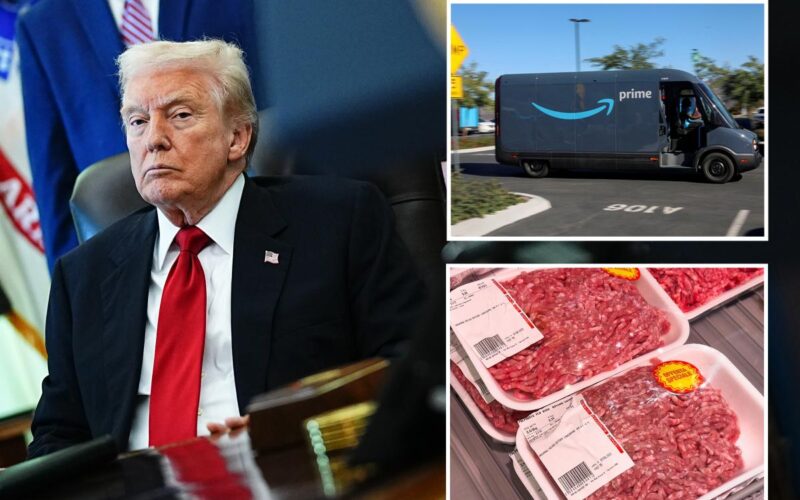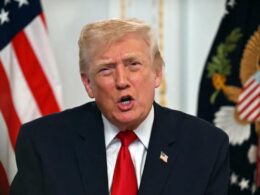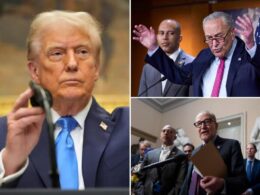With a social-media post that said “STOP LYIN” about there being an affordability crisis, President Trump claims he’s whipped inflation.
But consumers are still feeling the squeeze.
Target’s prices are up 5.5% nationwide this year and Walmart’s are up 5.3%, according to an analysis by DataWeave, which looked at roughly 16,000 items across each retailer’s website.
Amazon’s price hikes have averaged more than 12%, according to a report.
After seven months under Trump’s tariffs, Americans are paying more for nearly everything — from a cup of joe and plush living room sofas to children’s toys.
Inflation for food has been tamed to 3.1%, according to September’s Consumer Price Index — a far cry from the double-digit increases under President Biden.
But certain groceries, particularly meat, are still up for various reasons. Bananas are up 8.6%, mostly because of tariffs, as almost none are produced domestically. Chicken and eggs have fluctuated because of bird flu.
Beef is up across the board — up more than 19% for steak, and 14% for ground beef. Ranchers blame smaller herds because of drought. They are also helped by tariffs on foreign beef, and Trump says he’s considering consumer relief by boosting Argentinian imports.
“Putting Joe Biden’s inflation crisis firmly behind us has been a Day One priority for President Trump,” White House spokesman Kush Desai told The Post in a Thursday statement.
“Americans are paying less for essentials like gas and eggs, and today the Administration inked yet another drug pricing deal to deliver unprecedented healthcare savings for everyday Americans.”
He added that “the best is yet to come” as Trump’s agenda of tax cuts and deregulation continues.
Voters listed the economy as a major issue in this week’s election, and socialist Mayor-elect Zohran Mamdani campaigned on giving away free bus rides and other services because the city is too expensive.
In a social media post, Vice President JD Vance urged GOPers to “focus on the home front,” adding that affordability is “the metric by which we’ll ultimately be judged in 2026.”
Chris Sohan, 61, who lives in Queens and shops once a week for himself, his wife and son, doesn’t see any relief.
“Everything is expensive,” he said. “Maybe sometimes $50, sometimes $100,” he said he is now paying extra. “I am not buying more. I used to buy beef every week. Now I buy it every two weeks. I eat more chicken.”
Sohan voted for Trump twice, but has been disappointed.
“I expected better from him because of the promises he made. He cares more about his rich friends than he cares about me who voted for him. If I could go back [in time] I wouldn’t vote for him,” he said.
For months, businesses have been eating the bulk of Trump’s tariffs, which have hit key trade partners like China and Vietnam and goods like furniture, aluminum, vehicles and auto parts.
Now, companies have started to pass along those costs – and Goldman Sachs economists have warned that consumers will end up bearing the brunt of the bills by the end of this year.
Across Amazon, Target and Walmart, apparel prices rose 11.5% on average between January and the end of September, according to the data earlier reported by CNBC.
The big chains’ prices for home goods, pet goods and consumables, health and beauty items, and hardlines – like electronics, furniture and appliances – rose 10.8%, 6.1%, 7% and 8.3%, respectively.
It is more difficult for Amazon to avoid price hikes compared to rivals because it is largely a third-party seller, said Bill Currence, founder of Cornerstone Consulting Organization, which works with clients like Toyota, Volvo and Amazon.
But Amazon also “makes an insane amount of money because of the market share they control,” he added.
Most companies are probably following a rule to “never waste a good crisis” – and the real question is whether prices will come back down after the dust from the trade war settles, Currence told The Post.
Amazon disputed that its prices were up across the board.
“Across the selection of any large retailer, you can cherry pick products where prices have increased — if that’s what you’re looking for,” an Amazon spokesperson told The Post.
“The reality is that we offer competitive, low prices for Amazon customers and . . . we have not seen increases in price outside of normal fluctuations.”
A spokesperson for Target said the company has held prices steady on certain items, like school supplies. Walmart told CNBC it has permanently lowered prices on 2,000 items since February.
As an example of how tariffs are hitting prices: In October, Trump unveiled steep new tariffs on pharmaceutical drugs, kitchen cabinets, bathroom vanities, heavy trucks — and a 30% rate on furniture.
Later that month, IKEA hiked the price of a three-piece oak bedroom set to $1,049, up from $949 in August, according to the Wall Street Journal. It also raised the price of its Uppland sofa to $899, up from $849.
Federal data shows prices for living room, kitchen and dining room furniture — which is mostly imported from other nations — jumped 9.5% in September compared to the previous year.
Furniture and bedding rose 4.7% over the same period, while furnishings and supplies increased 2.8%.
Most low-cost furniture sold in the US — like a cheap chair — comes from overseas, particularly China.
But even high-end furniture in the US often contains textiles or other parts imported from abroad, according to Bob King, founder and CEO of Humanscale, which manufactures ergonomic office furniture.
Toys, video games and electronics have also been hit hard, since these goods are largely imported.
In August, Sony blamed Trump’s tariffs as it hiked the price of its Playstation 5 by $50 to $550. It claimed the tariffs are costing the company $685 million annually.
At Walmart, a T. rex toy jumped up to $55 in May, from $39.92 the previous month, according to social media posts.
The retailer’s Baby Born doll rose to $49.97 in May, up from $34.94 in March, while an Etch a Sketch increased to $24.99, up from $14.97 during the same period.
Fast-fashion firms have also hiked prices after Trump tossed out a tariff exemption that they used to skirt around US customs.
In October, a Mango jacket retailed for $649.99 for US customers — compared to just 299.99 euros, or about $347, in Spain, according to videos online.
River Island sold a coat for $247 in the US in October, but offered the same coat to UK customers for 110 pounds, or about $145.
A Zara skirt retailed for $69.90 in the US, but just 35.95 euros, or $42, in Spain.
Even the price of coffee is up a whopping 41% in September from the same time last year, according to the CPI.
Severe droughts and flooding have caused global shortages, and Trump’s tariffs on key suppliers like Brazil and Vietnam have added to costs.
Klatch Coffee, a family-run company based in Southern California, told The Post it has been forced to raise prices twice this year as costs have increased by $1.50 a bag.
Additional reporting by Georgett Roberts.








